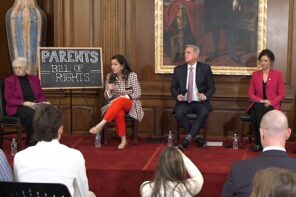Carl M. Cannon bemoans the current state of religion reporting as if there was a time when the press provided smart, in-depth, contextualized coverage of religious leaders, issues, ideas, and communities.
How did I miss that?
That Golden Era wasn’t in the 1980s when reporters treated evangelicals as bumblers and missed the significance of the conservatives’ takeover of the Southern Baptist Convention. And it surely wasn’t during the late 1940s and 1950s when, according to Debra Mason, “the abundance of syndicated religion content says more about demand for such content than it does about the quality of religion beat reporting, given its lack of originality and its low level of journalistic skill.”
Maybe reporters did a better job in the 1920s? Well, yes, if you agree with H.L. Menken’s characterization of Dayton, Ohio’s religious populace as “yokels,” “morons,” or “hillbillies.” Or if you’re fine with the anti-Semitic undertones in the coverage of the Leo Frank trial and the anti-Hindu coverage that ran through Western newspapers in the 1910s and 1920s.
Reporters were no more open-minded, judicious, or incisive in the 19th century. Newspapers went all out to cover religious scandal and sensation: the Tilton-Beecher adultery trial, the David Swing heresy case, and Dwight Moody’s barnstorming revivals were all reported in exquisite detail. Although many observers decried the lack of thoughtful reporting on the substantive religious issues of the day, story selection reflected the market. Sensationalism sold papers.
Despite these examples, there has been good, even excellent, reporting on religion but not nearly enough. So if today’s reporters get a few facts wrong, it’s sad, even embarrassing, but hardly a recent development. The real issue is not the lack of trained religion reporters, but rather Americans’ widespread ignorance about religion. Religion is absent from many high school curricula and university classrooms, and many of us barely know the religious history of our own country much less the role of religion worldwide.
Religion is too important to be left to a few experts. As Cannon points out, every educated person should know what Christians believe occurred at Easter and the Resurrection. Likewise, they should understand why Hebrew Bible is the more apt and less theologically-loaded term than Old Testament; when and why it is appropriate to use the appellation jihadi, and what differentiates Sikhs from Hindus. The historical, sociological, and theological basics of world religions need to be part of the American educational system. Once they are, coverage not just of religion but also of politics, culture, international affairs, and probably even sports, is bound to improve.
Yet, I’m not convinced that improving the American educational system is really at the heart of Cannon’s plaint about religion coverage and his subsequent post on Kermit Gosnell. Gosnell’s practice had tragic consequences for thousands of people. But the flat-out horror of his activities has been subsumed into a culture-war trope, so now there are more tweets, columns, and articles about the inadequate coverage of his trial than there are about the trial itself.
The Gosnell story is not a religion story, it’s a crime story. People with religious convictions may read their passions into it, but Gosnell did not seem to be motivated one way or the other by a faith commitment. Yet cultural religionists imply that the absence of religious commitment in the nation’s newsrooms—and consequent acceptance of baby-killing, oops abortion, is among the reasons that the Gosnell story was overlooked.
The notion that the news media is a secularist cabal ignoring stories that challenge its shibboleths is wrongheaded. The media is not sentient and its decisions are not logical. It reacts more than acts, often driven by random factors (What did my husband say over breakfast? Who’s trending on Twitter? When was the last time I read a story about ____?). Equally mistaken is the premise that if there were more believers in the nation’s newsrooms things would be different.
John Schmalzbauer, in his excellent study People of Faith: Religious Conviction in American Journalism and Higher Education, argues that a growing number of committed and vocal Catholics and evangelicals in the knowledge industries are making an impact on their respective fields. Moreover, Poynter recently noted that it’s almost impossible to know the numbers of Christians in the nation’s newsrooms.
Conor Freidersdorf neatly sums up the reasons why the Gosnell case initially didn’t get more attention, but I would boil his 14 explanations into one—with props to the Clinton War Room, “it’s the money, stupid.” The mainstream media, or at least most of it, is not interested in intellectual discourse, meaningful debate or public education. It’s interested in clicks, eyeballs, and money. If editors thought the Gosnell story would have captured public interest, they would have run with it. Now they know.




